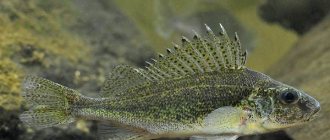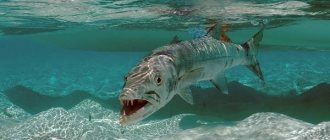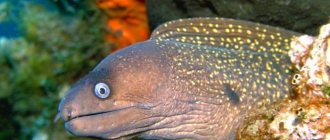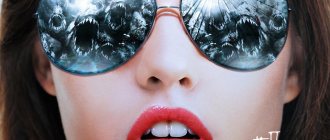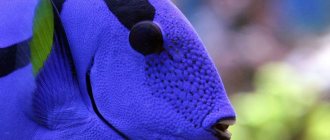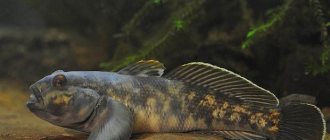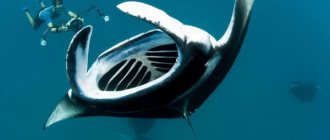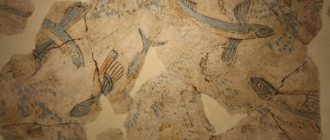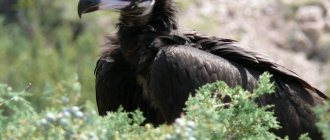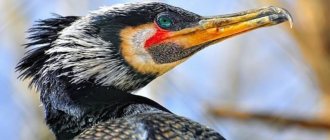Origin of the species and description
Photo: Dorado
The closest ancestor of fish is more than 500 million years old. This is a pikaya - several centimeters long, it did not have fins, so it had to bend its body to swim. The oldest fish were also similar to it: only 100 million years later did ray-finned fish appear, including the dorado. Since their appearance, these fish have changed very much, and the oldest species have long since become extinct; moreover, their immediate descendants have already become extinct. The first bony fish arose 200 million years ago, but the species inhabiting the Earth now appeared much later, most of them after the Cretaceous period.
Video: Dorado
It was then that the evolution of fish went much faster than before, and speciation intensified. Pisces became the masters of the seas and oceans. Although a significant part of them also died out - mostly species living in the water column survived, and when conditions improved, they began expanding back to the surface. Dorado was one of the first to appear in the Sparaceae family - perhaps even the very first. But this happened by the standards of fish not so long ago, at the very beginning of the Eocene, that is, a little more than 55 million years ago - the family as a whole is relatively young, and new species in it continued to form until the Quaternary period.
The scientific description of the dorado species was made by Carl Linnaeus in 1758, the name in Latin is Sparus aurata. It is from him that two other names come from which this fish is known: golden spar - nothing more than a translation from Latin, and aurata.
Appearance and features
Photo: What does a dorado look like?
The appearance of the fish is memorable: it has a flat body, and its length is three times its height - that is, the proportions are similar to crucian carp. The head has a sharply sloping profile with eyes in the middle and a mouth with a downward slit. Because of this, the fish always looks as if dissatisfied with something. It grows in length up to 60-70 cm, and weight can reach 14-17 kg. But this rarely happens, only in cases where the dorado lives to be 8-11 years old. The usual weight of an adult fish is 1.5-3 kg.
The color of the dorado is light gray, the scales are shiny. The back is darker than the rest of the body. The belly, on the contrary, is lighter, almost white. There is a thin lateral line, it is clearly visible near the head, but then gradually it becomes less and less visible, and is barely visible towards the tail. Sometimes you can see other dark lines running along the fish's body. On the dark head there is a golden spot located between the eyes. In juveniles it may be poorly visible, or even not visible at all, but with age it appears clearly.
Dorado has several rows of teeth; in front it has quite powerful fangs, indicating a predatory lifestyle. The teeth at the back are smaller than the front teeth. The jaws protrude slightly, the lower one being shorter than the upper one. The caudal fin is forked, with dark lobes; in the middle there is an even darker border. A noticeable pink tint to the color is noteworthy.
Where does the dorado live?
Photo: Dorado at sea
This fish inhabits:
- Mediterranean Sea;
- the adjacent Atlantic region;
- Bay of Biscay;
- Irish sea;
- North Sea.
Dorado lives most of all in the Mediterranean Sea - they can be found in almost any part of it from the very west to the eastern shore. The waters of this sea are ideal for golden steam. The waters of the Atlantic Ocean lying on the other side of the Iberian Peninsula are less suitable for it - they are colder, but they also have a significant population. The same applies to the rest of the listed seas and bays - the waters of the North or Irish Sea are not as favorable for the life of dorado as in the Mediterranean, therefore they are not inhabited by such large populations. Previously, dorado was not found in the Black Sea, but in recent decades they have been found off the Crimean coast.
Most often they live sedentary, but there are exceptions: some dorado flock in flocks and make seasonal migrations from the depths of the sea to the shores of France and Britain, and then back. Young fish prefer to live in river mouths or shallow and low-salt lagoons, while adults move to the open sea. The same is true with depth: young dorado swim close to the surface, and after growing up they prefer to live at a depth of 20-30 meters. During the breeding season, they dive much deeper, to 80-150 meters. In addition to wild dorado, there are also those bred in captivity, and their number is growing.
This fish was bred back in the Roman Empire, for which ponds were specially built, but real industrial breeding began in the 1980s. Now dorado is bred in all Mediterranean countries of Europe, and Greece is the leader in terms of production volumes. Fish can be grown in lagoons, floating cages and pools, and fish farms are becoming more numerous every year.
Now you know where the dorado fish is found. Let's see what she eats.
Dorado fish: calorie content and nutritional value, benefits and harm to the body, recipes
Dorado is a tasty fish that has been part of the diet of the peoples of the Mediterranean and Asia living near the seas for many centuries. Its use has a beneficial effect on human health and the functioning of the entire body. The composition of fish meat includes polyunsaturated and monounsaturated fatty acids, vitamins A, PP, and group B. Dorado is one of the leaders among the varieties of sea fish in terms of iodine content. It is also rich in calcium, phosphorus, iron, zinc and other essential minerals.
WEIGHT LOSS STORIES OF STARS!
Irina Pegova shocked everyone with her weight loss recipe: “I lost 27 kg and continue to lose weight, I just brew it at night. » Read more >>
Fish contains easily digestible protein, so nutritionists recommend it to athletes and people who want to lose extra pounds. Its regular use improves the functioning of the heart and thyroid gland, increases brain activity, and normalizes cholesterol levels in the blood.
Dorado is a tasty, nutritious fish of the Sparov family. All over the world it is also known under other names: sea crucian carp, coryphaena, golden spar, aurata.
The word “dorado” is translated from Spanish as “golden”. The sea creature received this name due to the characteristic golden stripes that are located on the forehead and between the eyes of the fish.
The dorado is found mainly in the waters of the Atlantic Ocean and the Mediterranean Sea. It is also grown under artificial conditions in Turkey, Greece, Spain and Italy. Delicious dishes are prepared from fish, which are considered delicacies in some countries. For example, the peoples of Asia Minor and the Mediterranean treat tourists and guests of their country with traditional dorado dishes.
The popularity of sea bass is due to its delicate taste and low calorie content in its meat.
The table shows the calorie content and nutritional value (BJU) of fresh golden steam per 100 grams:
The calorie content of dorado is 94 kcal.
The beneficial properties of fish for the human body are due to its rich chemical composition.
Doctors recommend eating dorado 2-3 times a week. Preference should be given to fish baked in the oven, grilled or in a slow cooker.
Benefits for the body:
- 1. Reduces cholesterol levels in the blood and prevents the development of atherosclerosis. Scientists have proven that people who regularly eat fish are less likely to suffer from heart disease.
- 2. Saturates the body with protein, which satisfies hunger and takes part in building muscle tissue.
- 3. Helps reduce weight. Nutritionists recommend eating dorado for people planning to lose extra pounds. Eating fish in combination with low-calorie foods has a beneficial effect on the functioning of the digestive tract and accelerates the process of losing weight.
- 4. Supplies brain cells with oxygen and stimulates thought processes due to the potassium included in the composition. Also, foods high in potassium help strengthen the heart muscle and normalize blood pressure.
- 5. Enriches with iodine, an element involved in the formation of thyroid hormones. In the human body, it also controls the thermoregulation of the body, is responsible for the proper development of the musculoskeletal system and promotes normal metabolism.
What does the dorado eat?
Photo: Dorado fish
Most often, the following enter the dorado’s stomach:
- shellfish;
- crustaceans;
- other fish;
- caviar;
- insects;
- seaweed.
Aurata is a predator that hunts other animals. Thanks to a large set of specialized teeth for different occasions, it can grab and hold prey, cut its meat, and crush its durable shells. With hunting, adult fish also eat caviar - both other fish and relatives. It can swallow insects and various small crustaceans and fry that fall into the water. The diet of young dorado is similar to adults, the only difference is that they are not yet able to fully hunt serious prey, as well as split shells, and therefore eat more insects, caviar, small crustaceans and fry.
The dorado has to feed on algae if it is not possible to catch anyone - animal food is still preferable for it. You need to eat a lot of algae, so it is often easier to hunt and eat for a long time than to constantly eat algae. Still, they are a source of important vitamins and microelements for fish. When artificially rearing dorado, they are given granulated food. It includes meat waste, fishmeal and soy. They grow very quickly on this food.
Interesting fact: There are other fish also called dorado, which sometimes causes confusion. Moreover, it even belongs to another family (Characinaceae). This is the species Salminus brasiliensis, and it lives in the rivers of South America.
Lifestyle of Sparus aurata fish
Dorada fish or sea crucian lead a sessile, bottom-dwelling lifestyle. They are found both alone and in small flocks. The most favorable climate for life is subtropical with water temperatures up to 26 °C.
4.1 Reproduction - time and characteristics of spawning
Dorada fish is a hermaphrodite. All fish born are male. Then, after reaching an age of more than 2 years, they turn into women. Puberty in men occurs between 1 and 2 years with a fish size of 20-30 cm, and in women between the ages of 2 and 3 years with a size of 33-40 cm.
4.2 Diet – what does Dorada eat?
Dorada fish (sea crucian) are mainly carnivorous, but if there is a shortage of food, they can supplement their diet with plant foods. The main sources of food are: shellfish (mussels, oysters, which it can easily crush with its powerful jaws), crustaceans (shrimp, small crustaceans), fish, sea worms, and, if necessary, seaweed.
Features of character and lifestyle
Photo: Dorado sea fish
Aurat differ from coryphaenas in that they usually live alone. They spend most of their time hunting: lying in wait for a careless fish and then suddenly grabbing it, or swimming to the surface and collecting insects that have fallen into the water. But most often they carefully examine the bottom of the sea, looking for edible crustaceans and mollusks. As fish hunters, golden spars are not so successful, and therefore the main source of their food is the bottom fauna, which cannot escape from them.
Often it has another defense - strong shells, but the dorado rarely manages to resist the teeth. That is why they live mainly in areas of the sea with shallow depths - so where they can explore the bottom. They move to deeper waters if there are large schools of fish there, which are easier to hunt. Dorado love calm, sunny weather - this is when they hunt and are caught most often. If the weather changes suddenly or it starts to rain, it is unlikely that you will be able to catch them. They are also much less active and if the summer is cold, they can even swim to another place where the weather is better, because they really love warm water.
Interesting fact: When purchasing dorado, you should check for freshness. The eyes of the fish should be transparent, and after light pressure on the abdomen there should be no dent left. If the eyes are cloudy or there is a dent, it means it was caught too long ago or was stored in improper conditions.
Dorado fish: calorie content and nutritional value, benefits and harm to the body, recipes
Dorado is a tasty fish that has been part of the diet of the peoples of the Mediterranean and Asia living near the seas for many centuries. Its use has a beneficial effect on human health and the functioning of the entire body. The composition of fish meat includes polyunsaturated and monounsaturated fatty acids, vitamins A, PP, and group B. Dorado is one of the leaders among the varieties of sea fish in terms of iodine content. It is also rich in calcium, phosphorus, iron, zinc and other essential minerals.
WEIGHT LOSS STORIES OF STARS!
Irina Pegova shocked everyone with her weight loss recipe: “I lost 27 kg and continue to lose weight, I just brew it at night. » Read more >>
Fish contains easily digestible protein, so nutritionists recommend it to athletes and people who want to lose extra pounds. Its regular use improves the functioning of the heart and thyroid gland, increases brain activity, and normalizes cholesterol levels in the blood.
Dorado is a tasty, nutritious fish of the Sparov family. All over the world it is also known under other names: sea crucian carp, coryphaena, golden spar, aurata.
The word “dorado” is translated from Spanish as “golden”. The sea creature received this name due to the characteristic golden stripes that are located on the forehead and between the eyes of the fish.
The dorado is found mainly in the waters of the Atlantic Ocean and the Mediterranean Sea. It is also grown under artificial conditions in Turkey, Greece, Spain and Italy. Delicious dishes are prepared from fish, which are considered delicacies in some countries. For example, the peoples of Asia Minor and the Mediterranean treat tourists and guests of their country with traditional dorado dishes.
The popularity of sea bass is due to its delicate taste and low calorie content in its meat.
The table shows the calorie content and nutritional value (BJU) of fresh golden steam per 100 grams:
The calorie content of dorado is 94 kcal.
The beneficial properties of fish for the human body are due to its rich chemical composition.
Doctors recommend eating dorado 2-3 times a week. Preference should be given to fish baked in the oven, grilled or in a slow cooker.
Benefits for the body:
- 1. Reduces cholesterol levels in the blood and prevents the development of atherosclerosis. Scientists have proven that people who regularly eat fish are less likely to suffer from heart disease.
- 2. Saturates the body with protein, which satisfies hunger and takes part in building muscle tissue.
- 3. Helps reduce weight. Nutritionists recommend eating dorado for people planning to lose extra pounds. Eating fish in combination with low-calorie foods has a beneficial effect on the functioning of the digestive tract and accelerates the process of losing weight.
- 4. Supplies brain cells with oxygen and stimulates thought processes due to the potassium included in the composition. Also, foods high in potassium help strengthen the heart muscle and normalize blood pressure.
- 5. Enriches with iodine, an element involved in the formation of thyroid hormones. In the human body, it also controls the thermoregulation of the body, is responsible for the proper development of the musculoskeletal system and promotes normal metabolism.
Dorado can be eaten by almost all people without restrictions. The only contraindication to its use is individual intolerance.
Many young mothers wonder about the benefits of fish for the body of a small child. It is not recommended to introduce sea crucian fish into the diet as a first complementary food, since it is grown in artificially created conditions. Pediatricians advise feeding babies cod, Atlantic salmon or trout.
Dorado has small bones, so it must be eaten with caution so as not to cause harm to health. This warning especially applies to children who may accidentally swallow a fish bone.
Nutritionists advise eating fish baked or grilled.
One of the healthiest ways to cook fish is baking it in foil. Below is a simple recipe that will pleasantly surprise you with its taste.
Ingredients for the dish:
- dorado - 2 carcasses;
- lemon - 1 pc.;
- onion - 1 pc.;
- olive (vegetable) oil - 4 tbsp. l.;
- garlic - 2 cloves;
- coarse salt (preferably sea salt) - 2 tsp;
- ground basil - a pinch.
Step-by-step preparation:
- 1. Remove scales from the fish, remove gills and entrails, rinse the carcass thoroughly and dry with a paper towel.
- 2. Scald the lemon with boiling water and grate 1 tsp. zest. Then cut it into rings along with the onion.
- 3. Prepare the marinade: pour lemon zest, sea salt, ground basil and finely chopped garlic with olive oil and mix thoroughly. Lubricate the dorado with the resulting marinade outside and inside.
- 4. Place some onion and 2-3 lemon slices on a sheet of foil. Place fish on foil. Top the carcass with a couple of onion and lemon slices. Wrap the foil tightly. Repeat similar steps with the second fish.
- 5. Bake in an oven preheated to 200 degrees for 20–25 minutes. Then open the foil and bake the fish for another 15 minutes until it browns.
Social structure and reproduction
Photo: What does a dorado look like?
If young fish usually live in schools near the shore, then after growing up they spread out, after which they already live alone. The exception is sometimes those dorado that live in areas of seasonal migration - they swim from place to place in flocks. Aurata is extremely remarkable in that she is a protandric hermaphrodite. The fish are still young, usually no older than two years – all of them are males. As they grow up, they all become females: if previously their sex gland was a testis, then after this degeneration it begins to work as an ovary.
Changing sex is useful for dorado: the fact is that the larger the female, the more eggs she will be able to lay, and the eggs themselves will be larger - which means that the offspring will have a higher chance of survival. But nothing depends on the size of the male. It spawns for the last three months of the year, and practically stops sleeping during this time. In total, a female can lay from 20 to 80 thousand eggs. They are very small, less than 1 mm, and therefore few survive - especially since many other fish want to feast on dorado eggs, and they take a long time to develop: 50-55 days.
If the eggs managed to remain intact for such a long time, fry are born. When hatching, they are very small - about 7 mm, at first they do not look like adult fish and are practically helpless. Nobody protects them, so most of them die in the jaws of predators, mainly fish. After the fry grow a little and take on a dorado-like appearance, they swim to the coast, where they spend the first months of their lives. Young but grown fish can already fend for themselves and become predators themselves.
In artificial breeding, there are two approaches to raising fry: they are reared either in small tanks or in large tanks. The first method is more productive - for every liter of water, one and a half to two hundred fry hatch, because its quality can be very precisely controlled and made ideal for breeding them. In large pools, the productivity is an order of magnitude lower - there are 8-15 fry per liter of water, but the process itself is similar to what happens in the natural environment, and persistent fish appear, which can later be released into the reservoir.
For the first few days, the fry feed on reserves, and on the fourth or fifth day they begin to be fed with rotifers. After ten days, their diet can be diversified with artemia, then vitamins and fatty acids are gradually introduced into it, microalgae are added to the water, and they begin to feed crustaceans. By one and a half months they have grown enough to be transferred to another body of water and fed with granulated food, or to be released into a creek or other environment close to natural.
How to prepare sea bream
Dorado is considered a fish that is almost impossible to spoil during the cooking process. Any processing method is suitable for it: from the most common baking to steaming. Some even eat it raw! Any side dish and sauce goes well with this Mediterranean fish; it is cooked with vegetables, marinated in wine, and a variety of products are used, including mango puree. In each country where dorado is caught or sold, there is its own special recipe, and maybe several recipes. It tastes very similar to sea wolf (sea bass), which is why they are often called interchangeable. Its meat is light, with a pinkish tint, and turns white when cooked. The fish is firm but juicy. Often it is cooked whole, right with the tail and head. There are practically no large seeds in sea bream, but there are a few small ones, so it should be given to children with caution.
Natural enemies of dorado
Photo: Dorado
This fish is large enough to attract large aquatic predators such as sharks, but small enough to fight them. Therefore, they are the main threat to dorado. The Mediterranean Sea and the Atlantic are home to many species of sharks: sandbar, tiger, blacktip, lemon and others. A shark of almost any species is not averse to snacking on a dorado - they are generally not particularly picky eaters, but they are clearly attracted to dorado more than other prey and, if they see this fish, they strive to catch it first. Probably, dorado is the same delicacy for them as it is for people.
People themselves can also be counted among the enemies of the dorado - despite the fact that a large number of this fish are bred on fish farms, fishing is also active. The only thing that hinders him is that dorado live alone, so it’s difficult to catch them purposefully, and usually this happens together with other species. But adult fish are large enough not to be afraid of most of the predators found in sea waters. The eggs and fry are in much greater danger. The eggs are actively eaten by other fish, including small ones, the same applies to fry - they, moreover, can be caught by birds of prey. Especially large ones also hunt for young dorado weighing up to a kilogram - after all, birds of prey, in general, cannot cope with already adult, large individuals.
Interesting fact: Dorado can be gray or royal - the second type has a more delicate fillet, colored slightly pinkish.
